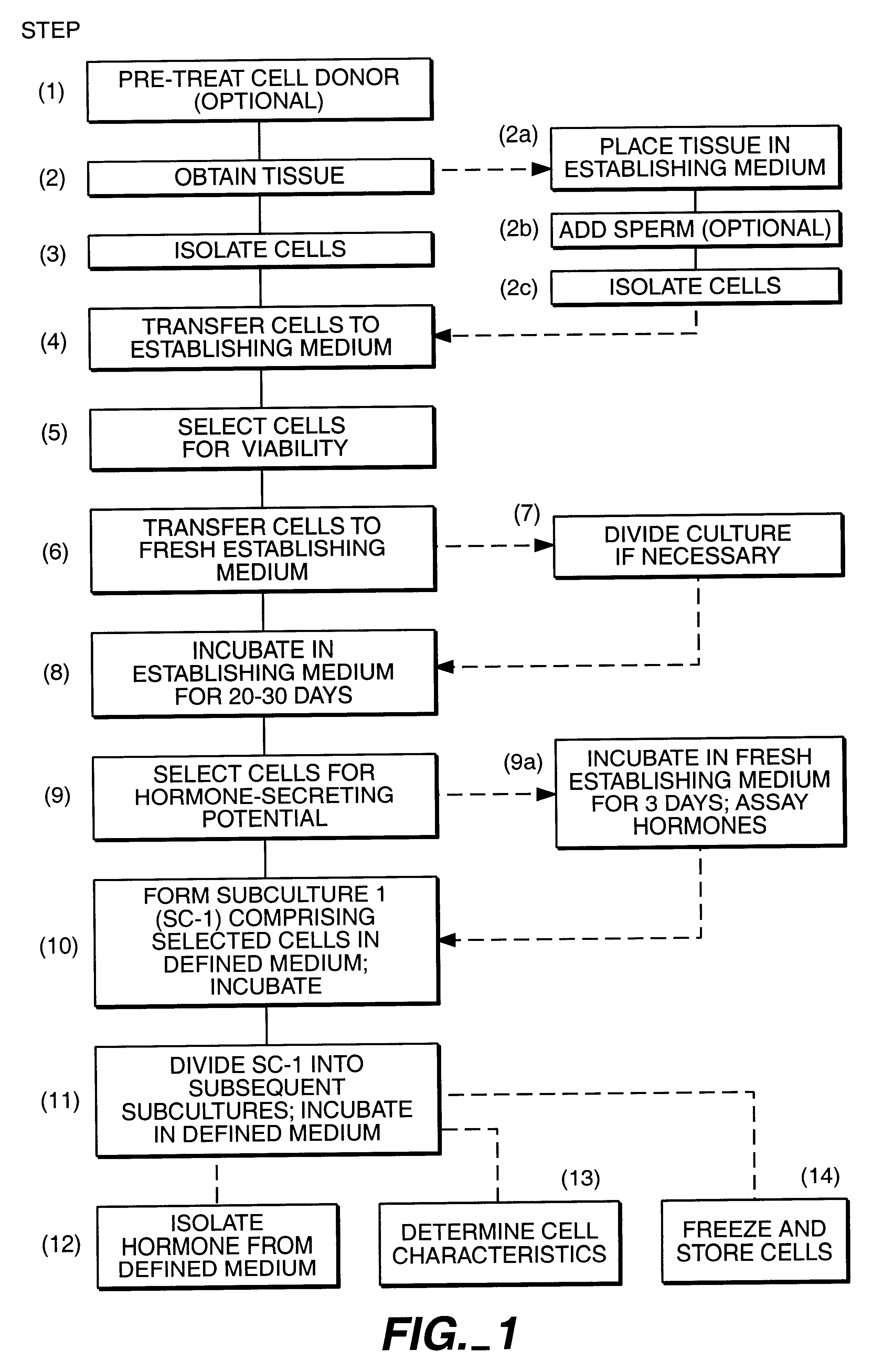Hormone-secreting cells maintained in long-term culture
a technology of secreting cells and culture, applied in the field of hormone-secreting cells maintained, can solve the problems of not promoting the long-term survival or proliferation of hormone-secreting cells, most types of normal cells have a limited life span in culture, and cultures are self-limiting, so as to increase insulin secretion and glucose concentration
- Summary
- Abstract
- Description
- Claims
- Application Information
AI Technical Summary
Benefits of technology
Problems solved by technology
Method used
Image
Examples
example 1
This example sets forth a method for establishing human granulosa cells in culture using donor serum in the establishing medium.
Cell source: The cells in this example were obtained from follicular cells which accompanied ova extracted from patients undergoing in vitro fertilization.
Donor serum: Blood was collected from each cell donor 24 hours before ovum retrieval and was allowed to thoroughly clot. The clotted blood was centrifuged at 2700 rpm for 10 min. The clear serum was carefully removed, placed in a sterile Falcon tube and centrifuged again to remove any residual erythrocytes. The serum was used only if there were no signs of hemolysis. The serum was removed, placed in another sterile Falcon tube and heat inactivated at 57.degree. C. for 30 minutes. The heat inactivated serum was filtered with a 0.20 micron Nalgene filter and collected into a sterile Falcon test tube before use in making the BDM and EM.
The formulations for BDM and EM were based on an initial formulation of b...
example 2
This example sets forth a method for maintaining and propagating hormone-secreting cells in long-term culture.
Upon completion of the initial 30 days of establishing culture (Example 1), the sub-culture selection process was begun. Initial sub-cultures (SC-1) of small groups of cells were manually selected. Cell selection was performed under phase optics according to selection criteria illustrated in FIGS. 2, 3, and 4. The circled clumps of cells are representative of the type of cell clumps that were chosen as most likely to have hormone-secreting potential. Small clumps of 2 to 12 cells were chosen, most often clumps of 4 to 5 cells. Typically, the cells in the selected clumps were arranged in a semi-linear fashion, i.e., touching each other in a "string-of-pearls" type arrangement. The selected cells were approximately spheroid or ovoid in shape, and were of approximately homogeneous size and shape. The selected cells typically had a smooth appearing membrane, and a smooth-appeari...
example 3
This example demonstrates the level of cell propagation achieved in cultures of hormone-secreting cells.
Cell counting methods: For seeding original primary cultures, as in Example 1, and first sub-cultures, as in Example 2, cell number was established by direct counting through an inverted phase microscope as the cells were being selected. At various time points after seeding, cell number was established by counting and averaging numbers of cells contained in multiple drops on a Makler counting chamber (Sefi Medical Instruments, Haifa, Israel). The Makler counting chamber has a grid 0.01 mm.sup.2.times.0.01 mm depth.
Representative samples of cell concentrations were obtained either directly from suspension cultures or from cell populations that had been detached from substrate.
Results: During the first six days in the first sub-culture, SC-1, cell number typically increased about 3 fold. Typical SC-1 results are shown below in Table 2.
During the later part of SC-1, and during subseq...
PUM
| Property | Measurement | Unit |
|---|---|---|
| synthesis time | aaaaa | aaaaa |
| synthesis time | aaaaa | aaaaa |
| total culture time | aaaaa | aaaaa |
Abstract
Description
Claims
Application Information
 Login to View More
Login to View More - R&D
- Intellectual Property
- Life Sciences
- Materials
- Tech Scout
- Unparalleled Data Quality
- Higher Quality Content
- 60% Fewer Hallucinations
Browse by: Latest US Patents, China's latest patents, Technical Efficacy Thesaurus, Application Domain, Technology Topic, Popular Technical Reports.
© 2025 PatSnap. All rights reserved.Legal|Privacy policy|Modern Slavery Act Transparency Statement|Sitemap|About US| Contact US: help@patsnap.com

